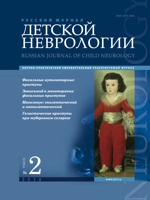Vol 9, No 2 (2014)
- Year: 2014
- Published: 15.04.2014
- Articles: 9
- URL: https://rjdn.abvpress.ru/jour/issue/view/2
Full Issue
AUTHENTIC ARTICLES
 6-14
6-14


THE CLINICAL, ELECTROENCEPHALOGRAPHIC, AND NEUROIMAGING CHARACTERISTICS OF PATIENTS WITH EPILEPTIC EYELID MYOCLONIA
Abstract
Epileptic eyelid myoclonias with and without absences are epileptic seizures manifesting as eye closure or frequent (3–6 times per second) rhythmic eyelid myoclonias (eyelid jerk). They may be accompanied by brief absences or may run without loss of consciousness. The authors provide a detailed review of literature and their study results in 34 patients (detected in the entire group of 1261 patients) with epileptic eyelid myoclonia with regard to their anamnestic, clinical, electroencephalographic, and neuroimaging features. Detailed recommendations for its diagnosis and treatment are given.
 15-23
15-23


EPILEPSY IN ELDERLY PATIENTS (DIAGNOSTIC FEATURES)
Abstract
Physicians frequently consider that epilepsy is a disease in children and young adults; however, its incidence in elderly patients is not lower and commonly higher than those among children and young people. Among the causes of epilepsy in elderly patients, there is a predominance of acute and chronic cerebral circulatory disorders (50 % of all cases). Other causes of epilepsy (neurodegenerative processes, tumors, etc.) are rarely encountered in the elderly. However, there is actually no real pattern of incidence of epilepsy in the elderly since the diversity and features of its clinical manifestations in these patients, as well as difficulties in describing their status make the diagnosis of the disease very hard in this category of patients. Seizures without loss of consciousness, which are especially associated with the development of transient muscle tone disorders and autonomic dysfunction, are commonly regarded as benign vertigo, autonomic or mental disorders. This study has indicated that the development of epilepsy in the elderly, which results from cerebrovascular and neurodegenerative pathology, is not a rare, but relatively common neurological disorder. By taking into account the aging tendency in economically developed countries, the increasing number of elderly patients with epilepsy is an important medical and economic problem that calls for in-depth investigation, timely diagnosis,
and treatment.
 24-29
24-29


REVIEWS AND LECTURES
THE PROBLEM OF AGGRAVATION OF EPILEPTIC SEIZURES DURING THERAPY WITH ANTIEPILEPTIC DRUGS
Abstract
The paper gives a brief literature review coming to the attention of practitioners to the problem of aggravation in epilepsy. Despite the fact that the purpose of use of antiepileptic drugs is to stop seizures and to suppress epileptic activity on electroencephalogram; in some cases their administration may worsen epilepsy, namely may make seizures more frequent and severer (may cause aggravation). Status epilepticus is the severest manifestation of aggravation. The drugs differ in the risk of aggravation, which also depends on the type of seizures and patient age.
 30-31
30-31


MYOCLONUS IN CHILDREN: DEFINITIONS AND CLASSIFICATIONS, DIFFERENTIAL DIAGNOSIS, APPROACHES TO THERAPY (A LECTURE)
Abstract
Myoclonus is a manifestation of many neurological diseases, by differing in etiology and pathogenesis. The high prevalence of myoclonus in children with cardinally different prognoses of diseases of not only the nervous system, but also other organs and systems causes to resume investigations into myoclonus as a syndrome, to specify its terminology and classification, to improve diagnostic criteria, and to optimize additional diagnostic schemes.
 32-41
32-41


USE OF ZONISAMIDE (ZONEGRAN) IN THE TREATMENT OF EPILEPSY: EMPHASIS ON MONOTHERAPY OF FOCAL SEIZURES (A REVIEW OF FOREIGN LITERATURE)
Abstract
Despite a considerable advance made in epileptology, resistant epilepsies are about 30 % among all epilepsy types. The paper reviews the current literature dealing with the efficacy and safety of the new antiepileptic drug zonisamide (Zonegran) in the treatment of epilepsy. It describes the mechanism of action, pharmacokinetics, efficacy, and tolerability of zonisamide in resistant epilepsy. The authors focus their attention on recent trials of zonisamide used in monotherapy.
 42-49
42-49


CLINICAL OBSERVATIONS
GELASTIC SEIZURES IN TUBEROUS SCLEROSIS
Abstract
The authors consider the historical description, nosological entity, clinical and electroencephalographic manifestations of gelastic seizures, a rare type of epileptic seizures manifesting as sudden attacks of spasmodic laughter. They describe their case of gelastic seizures in a child with tuberous sclerosis.
 50-54
50-54


THE DIAGNOSIS AND TREATMENT OF JEAVONS SYNDROME
Abstract
The authors describe their clinical case of a female patient with Jeavons syndrome, a rare type of reflex idiopathic epilepsy. By using the data of her medical history, clinical, neurological and neurofunctional studies as an example, they show the complexity of a diagnostic search, errors and difficulties in the choice of therapeutic policy. The typical clinical manifestations of Jeavons syndrome are eyelid myoclonia with absences, eyeclosure- induced seizures, and photosensitivity, which are highly resistant to antiepileptic drugs. The introduction of current neuroimaging methods has increased the degree of evaluation the etiology of Jeavons syndrome.
 55-59
55-59


ADVANCED TRAINING
 60
60











